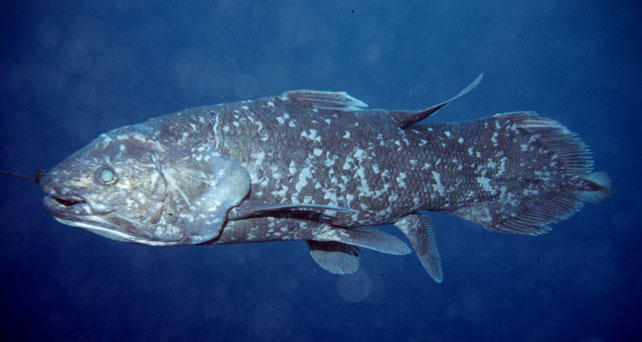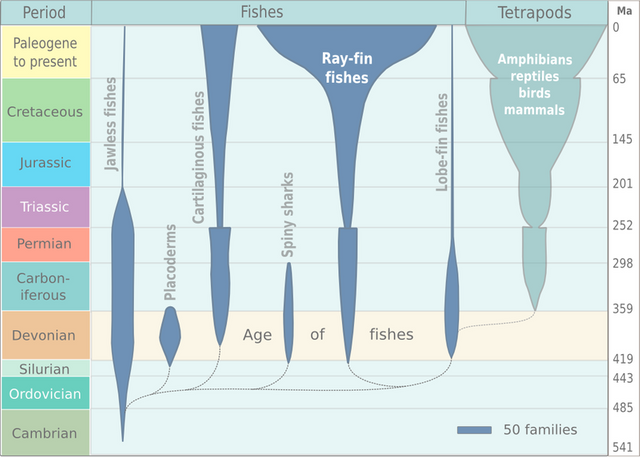Living Fossils: The Coelacanth
It may have been discovered in 1938, but it's still hard to find a fish that people get more excited about than the Coelacanth. It's nowhere near the flashiest fish around, but to anyone who's ever spent much time around fish, it's an immediately striking one. It's got a wide variety of features that distinguish it from other fish, but the biggest one? It's a member of an otherwise nearly extinct clade of fish known as the lobe-finned fish that had their heyday on Earth before the dinosaurs even arrived. On top of that, lobe-finned fish are our ancestors, making coelacanths our great-great-great-ad nauseum uncles.

The Indonesian coelacanth, Latimeria menadoensis, the second species discovered. [Image source]
Coelacanths are deep dwelling fish (~200 meters) that grow to around the size of a human being. (~5 feet). They're slow moving, except for the occasional burst of speed to catch prey or escape danger. They have extremely photosensitive eyes- they only hunt at night in deep water, and will remain in their caves during the day or even the full moon to avoid damaging their eyes. They also possess a strange sensory organ called the rostrom in their nose to help detect the electromagnetic fields of their prey. Their curious three lobed tail is possessed by no other animal in existence.
Each coelacanth is easily recognized as an individual. While the two species are slightly different colors, both have light colored scales scattered among the dark scales. The large, armor-like scales are arranged in unique patterns on every fish, so scientists diving or piloting subs in the deep can easily learn to recognize individuals.
Their most unusual feature, however, is their fins. Instead of the branching bones found in the fins of ray-finned fish, which compose most fish species alive today, they have a single thick limb running down the center of each fin. Essentially, it's the limb that evolved into legs on land animals. The fins have a joint similar to human shoulder or hip joints, allowing 180 degree rotation. They move their fins in a manner remarkably similar to the way that lizards walk- moving a front fin at the same time as they move the back fin on the other side. This makes the clunky, awkward looking fish into one of the most graceful swimmers in the ocean. They can swim forwards or backwards with ease, can turn on a dime, and are often found doing headstands. They can even swim upside down!
Coelacanths and lungfish, the only other surviving lobe-finned fishes on the planet, are actually more closely related to land animals, including us, than they are to other fish. While they're not our direct ancestors, they're reasonably closerelatives to them. They're still quite a distance away on the family tree, of course- they lack backbones, instead having primitive notochords filled with fluid.
These majestic living fossils were rare when we first discovered them, and have since gotten even rarer. The first species discovered, Latimeria chalumnae, has a population that might now be as small as 500 individuals or less. Many of them were caught for scientific research, but the greatest threat to them is as bycatch- Comoros fisherman often catch them when seeking oilfish, who are a similar size and have similar hunting habits. The Indonesian coelacanth, Latimeria menadoensis, is in better condition, with a population measuring possibly as high as 10,000, but still remains quite vulnerable. A black market trade in them has also started- Chinese medicine has added them to the list of endangered species that provide supposed miracle cures- in this case, coelacanth notochord fluid is claimed to grant immortality. Active protection of coelacanths is necessary if we are to preserve these wondrous remnants of ancient time.
If you're interested in reading more about the coelacanth, I highly recommend reading Samantha Weinberg's excellent A Fish Caught in Time: The Search for the Coelacanth.
Bibliography:
A Fish Caught in Time: The Search for the Coelacanth, by Samantha Weinberg
http://vertebrates.si.edu/fishes/coelacanth/coelacanth_wider.html

@originalworks
The @OriginalWorks bot has determined this post by @mountainwashere to be original material and upvoted it!
To call @OriginalWorks, simply reply to any post with @originalworks or !originalworks in your message!
To enter this post into the daily RESTEEM contest, upvote this comment! The user with the most upvotes on their @OriginalWorks comment will win!
For more information, Click Here! || Check out our contests as well!
Special thanks to @reggaemuffin for being a supporter! Vote him as a witness to help make Steemit a better place!
This post was great mountain. I love sea creatures and in deep, dark water we find some of the most fascinating. Thanks for this very informative post on a magnificent creature.
"coelacanth notochord fluid is claimed to grant immortality" haha oh boy, the things people come up with. I sense a short story developing in my mind inspired by this...
I want to read that story!
you do understand that this can get your amazon affiliate account killed? have you read the TOS? no aff links alllowed on sites you don't own (except twitter & facebook). :)
I did not, I totally missed that while signing up! I'll leave off doing it on steemit and just save it for my personal blog! Thank you!
no worries ^__^. If you do a google search you will find hundreds of people that have lost their account this way !
Is it the use of originalworks you mean?
It looked like something i could be interested in, but now i am afraid to use it before i am sure it is legal to use in steemit..
i am talking about amazon affiliate links inside the post :)
aha.. thank you for the clarification. :)
:*
Where is this native to?
One species of coelacanth is found in Cormoros and Madagascar, the other in Indonesia. There are rumors of a third species, but they're only unconfirmed rumors at present.
Interesting.
I find it remarkable that so many unique species live on Madagascar. Add to that when you play Pandemic, Madagascar survives 9 out of 10 times...
Coincidence? lol
It's a topic studied heavily by this obscure science known as biogeography- essentially, the study of how location effects evolution. Island biogeography is the most important subfield- the study of how isolated populations evolve, which tends to happen at much faster rates than larger, non-isolated populations do. Madagascar, as the third largest island on the planet, has so many diverse species due to a combination of this evolutionary principle plus a lot of species surviving on Madagascar that have gone extinct on mainland Africa.
This is amazing info- thank you! I did not know this
You should check out the book The Song of the Dodo, by David Quammen. It's all about island biogeography. One of my favorite nonfiction books of all time.
Sweet, I am definitely going to - thank you again!
Of course! I love giving book recommendations, so it's my pleasure.
I remember talking about this fish in my comparative anatomy classes. A lot of good information, here. Interesting read!
Thanks! And yeah, this would be a good fish to talk about in comparative anatomy- not a lot like it on the planet.
Fantastic post! I love the Coelacanth. It seems that it is (even being a bone fish) is somewhat similar to cartilaginous fishes (sharks).
Coelacanths have tons in common with sharks! Both of them contain high levels of urea (the nitrogen compound found in mammal urine) in their blood, for instance. They do that keep from losing water to osmosis, since the ocean is saltier than their blood. Fish drink tons of water in the ocean, because otherwise they're at huge risk of getting dehydrated via osmosis. Sharks and coelacanths have to drink much less water because of the urea concentrations.
And coelacanth skeletons actually use a lot more cartilage than bone, though they do have both.
Congratulations @mountainwashere! You have completed some achievement on Steemit and have been rewarded with new badge(s) :
Click on any badge to view your own Board of Honor on SteemitBoard.
For more information about SteemitBoard, click here
If you no longer want to receive notifications, reply to this comment with the word
STOPYou've received an upvote from #TheUnmentionables - a SteemIt community full of members who like to kick ass, take names, and occasionally do it wearing (or forgetting to wear) our unmentionables...
Please upvote this comment so we can help our members grow faster!
It's amazing to see prehistoric fish still around. What if there are still other prehistoric species still lurking around there? That would be a find.
There almost certainly are! Lake Vostok is a good option for looking for prehistoric life- it's a subglacial lake in Antarctica that's been isolated for 20 million years. I did a post on it a while back. On top of that, there's almost certainly more prehistoric creatures living in the ocean as well.
That is amazing! I can't imagine what other creatures are still alive down there. Will check your old post too I'm a sucker for these kinds of stuff. :)
I blog about science stuff all the time- that and historical topics. My next post is going to be on trilobite eyes.
Interesting I'll look forward to your post buddy.
@mountainwashere got you a $9.44 (4.0%) @minnowbooster upgoat, nice! (Image: pixabay.com)
Want a boost? Click here to read more about @minnowbooster!